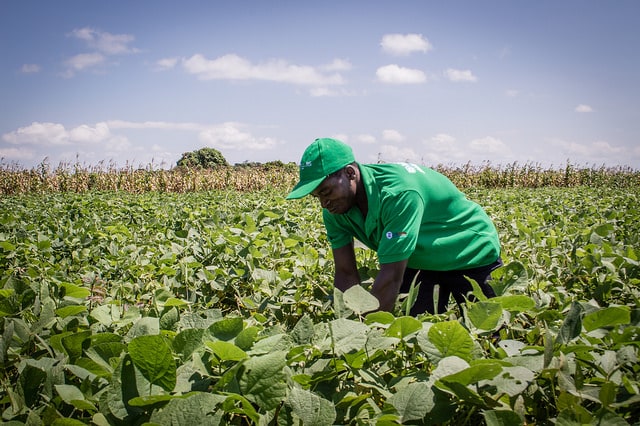A Farmer in Mozambique Faces an Unfamiliar Pest
Working with global partners, farmers are growing more despite the invasive fall armyworm.
Far off from the main road, the sun beats down on a maize field in Mozambique. It’s the hottest part of the day, and Ufece Joao is out managing his family’s three-hectare field. Day-in and day-out, this is where Ufece spends most of his time. The yields feed and provide for his family of four.
But Ufece’s field is under threat from an unfamiliar pest. It doesn’t take a mid-day break, and neither does he.
“I started seeing fall armyworm last year,” he said. “This year, [the pests’] numbers have increased. It hurts me to see them. I tried getting rid of them by hand, but it’s gotten out of control.”

Fall armyworm (FAW) is a new pest to Mozambique — and to farmers across the African continent. In its larval stage, the bug feeds on more than 80 plant species, including maize, rice and vegetables. FAW is only susceptible to pesticides for a small window of time, and application is expensive and potentially toxic to farmers and other insects that eat FAW. Left unmanaged, FAW can cause significant yield losses for farmers, which puts farming families like Ufece’s in a vulnerable situation, as they lose critical income and food.
Since 2016, a Feed the Future project has been helping Mozambican producers like Ufece improve their agricultural productivity. When FAW started to make its way to Mozambique, the project’s implementer, Land O’Lakes International Development, began looking for ways to help farmers like Ufece manage the pest.
Through Land O’Lakes International Development’s affiliation with Land O’Lakes, Inc., a leading U.S. agribusiness, Feed the Future was connected to Villa Crop Protection, a South African company co-owned by Land O’Lakes, Inc. Villa sent three experts to Mozambique to do an on-farm training with Feed the Future agronomists and model farmers like Ufece on a “push-pull” methodology for suppressing FAW.
During these trainings, the group discovered that by teaching farmers to intercrop fields with legumes, Feed the Future was already practicing the “push” portion of the methodology. The legumes acted as a repellent to the FAW moth as it tried to lay its eggs. This left just the pull half, which involved planting attractive grasses like elephant grass around the perimeter of a field to pull pests like FAW away from vulnerable crops. This had the added benefit of reducing soil erosion too.
Next growing season, Ufece will plant elephant grass around his field and will continue to apply other practices he has learned from Feed the Future. Ufece is also sharing the practices he learned with 32 people in his community. Over the life of the project, model family farmers like Ufece are expected to reach over 5,600 families in the region.
Though Ufece will still face challenges, he is happy that his yields are improving and that he now has tactics to protect his field — and his family’s food security.
“Before [Feed the Future], I didn’t know how to deal with pests,” Ufece said. “In agriculture, you need to plan. Now I know my plan.”
The Feed the Future Resilient Agricultural Markets Activity — Beira Corridor is funded by USAID and implemented by Land O’Lakes International Development. Addressing Fall armyworm is a critical challenge for farmers across Africa. That is why Land O’Lakes International Development is contributing $50,000 towards Feed the Future’s Fall Armyworm Tech Prize. It is also why, with the support of USAID and the Alliance for a Green Revolution in Africa, Land O’Lakes International Development and Villa Crop Protection have teamed up with Monash University in Australia to train 75 private-sector leaders on fall armyworm identification and mitigation.
